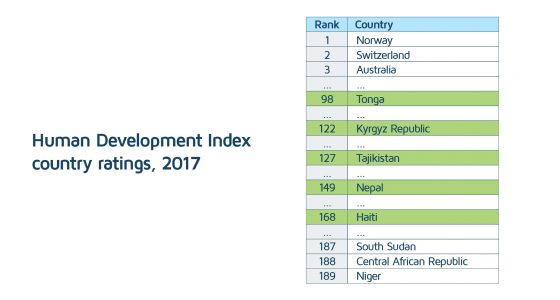It is no secret, that for many developing countries, remittances sent by their citizens who work abroad to their families and friends back in the homeland are an important financial resource for day to day existence. The global amount of remittances made to low- and middle-income countries has experienced year-on-year growth and reached a record high of $529 billion in 2018 (a 9.6% increase compared to 2017). For some countries, this revenue stream represents more than a quarter of their Gross Domestic Product (GDP). In this analysis, you will discover which developing countries rely most on remittances from their migrant workers and learn whether this financial flow has a positive impact on the development of those countries.
At the beginning of the year, the World Bank group announced that, in 2019, remittance flows to low- and middle-income countries were expected to reach $550 bn and were set to become those countries’ largest source of external financing. Although this may appear to represent a major asset in economic development, some say that the impact of remittances to private households may also cause the stagnation or the worsening of the situation overall.
So, to what extent has the growth in the level of remittances made to the TOP-5 countries, for which personal remittances represent the highest percentage of GDP, influenced their economic growth and the Human Development Index (HDI)?

Tonga
The most recent data available reveals that remittances received by the population of Tonga in 2018 equaled almost 41% of the country’s GDP which makes the country first in the list of the TOP-5 that rely on remittances. Although the amount of $187 million may seem minuscule when compared to the amounts received by the other four countries on the list, but for the country’ population of 105,000 it is not. In the period between 2010 and 2018, the percentage share that remittances contributed to the GDP encountered significant growth from 20% GDP to almost 41%. However, the GDP value has not enjoyed a similar positive trend, fluctuating between $350 million in 2010, $472 million in 2012 and $450 million in 2018.
At the same time, the HDI in Tonga has consistently grown from 0.712 in 2010 to 0.726 in 2017. This indicator, designed by the United Nations, is used to measure and rank countries according to their social and economic development levels. The value registered by Tonga is described as ‘high human development’ and the country is ranked 98 out of 189 states for which HDI is calculated.
According to the UN Sustainable Development Report 2019, and despite the high human development index, Tonga faces ‘major’ and ‘significant’ challenges in most of the 17 Sustainable Development Goals. Only two trends of SDG implementation are ‘on track’ while the other are ‘stagnating’ or ‘missing’ relevant data.
When considered together, the value and trends of remittances’ income, the HDI evolution and the status of the SDGs implementation, suggest that the development of this small insular country has not been significantly triggered by growing remittances from abroad.
Kyrgyz Republic
In 2018, Kyrgyz migrant workers who preferred to find a job in the Russian Federation sent home nearly $2.5 bn, representing 33% of the country’s GDP. Between 2010 and 2018, the percentage share of remittances grew from 26% to 33%, with a temporary drop in 2014-2015 due to economic turbulence in Russia. The country’s GDP also encountered a similar trend, growing from $4.7 bn in 2010 to $8.09 bn in 2018.
The Human Development Index in this Asian country also enjoyed a positive trend, fluctuating between 0.636 and 0.672. However, this HDI value designates the living conditions as ‘medium human development’ for Kyrgyz inhabitants.
Compared to Tonga, the Kyrgyz Republic is slightly better in terms of the SDGs it is achieving. The country is still facing certain ‘significant and ‘major’ challenges but the majority of SDG implementation trends are qualified as ‘moderately increasing’ and ‘on track’ by the 2019 UN Sustainable Development Report.

Haiti
With a total population of 11.1 million people, money remitted home by migrant workers from Haiti represents 32.5% of the country’s GDP. The financial value of these remittances has been growing on an annually basis – from $1.7 bn in 2010 to $3.1 bn in 2018, while the GDP encountered moderate fluctuations with a prominent positive trend in the period from 2010 to 2014 followed by stagnation in 2015 and 2016 before making a recovery in 2017.
Despite the GDP fluctuations, the HDI encountered a positive trend between 2010 and 2017, ranging from 0.47 to 0.498. However, this value is the lowest among the TOP-5 countries featured, ranking Haiti at 168th out of the 189 states monitored by the UN which is considered as ‘low human development’.
At the same time, according to the UN Sustainable Development Report 2019, Haiti faces multiple ‘major’ challenges with 13 of the 17 SDGs and is ‘stagnating’ on tackling them. These statistics suggests that, although remittances represent a high percentage share of the GDP, the patterns of investment are different from those that could influence the social and economic development in the country. Thus, despite the increase in remittances received, Haiti faces severe challenges in its social and economic development.
Tajikistan
With nearly one-third of its population living below the poverty line, Tajikistan is another country that is highly dependent on remittances which, in 2018, amounted to over 29% of the country’s GDP, totaling $ 2.18 bn. Similar to the Kyrgyz Republic, the flow of remittances changed during the 2014-2015 crisis in the Russian Federation, from where the majority of the Tajik migrant workers send home their monthly wages.
Despite the positive trend of increase in remittances, the UN’s Human Development Index for Tajikistan does not register a clear evidence of progress. The values of 0.634 points in 2010 to 0.65 points in 2019 show that the country is struggling to ensure better living conditions for its population and that progress is rather slow. The country encounters ‘medium human development’ conditions and is ranked 127 of the 189 monitored countries worldwide.
This fact is confirmed by the 2019 UN Sustainable Report. With only one SDG achieved (Responsible consumption and production), ‘significant’ and ‘major’ challenges to the implementation of other SDGs remain although their status is ‘moderately improving’.

Nepal
Similar to other developing countries in the Asian region, the Nepalese are constantly attracted by higher salaries and better work opportunities abroad. With over 350 thousand new work permits issued annually for Nepalese citizens who are planning to work abroad, the percentage of the share represented by remittances of the country’s GDP stalled at 27.9% in 2018, practically repeating the 2017 value. The financial value of the remittances sent home has grown from $6.9 bn to $8.0 bn. The consistent percentage share of that remittances contribute to the country’s GDP is explained by the growth of the GDP itself on a proportionate scale.
Does the growth in the GDP and remittances’ influence the HDI and the implementation of SDGs? Although the Human Development Index for Nepal has continually improved over the last decade, social and economic development remains worse than that of Tajikistan and the Kyrgyz Republic. The country ranks 149 out of 189 states and the HDI value of 0.574 indicates ‘medium human development’ conditions.
In developing countries, remittances are one of the most important sources of income for the population and, while their impact on poverty reduction is evident since the people who receive this revenue have a higher income, the effect of remittances on economic growth is still a subject of dispute. The reasons for this are multiple, since the positive impacts are counterbalanced by negative aspects such as a huge outflow of workers, the behavioral characteristics of the receiving groups who choose more leisure over labor, chaotic consumerism and rapidly growing imports. All of these factors have a negative impact on economic growth. Furthermore, in the long term, a massive outflow of population could be the cause of major social and demographic problems, such as generations of children and youths growing up without parents and the exodus of the young population.
Governments in countries such as Tonga, Nepal, the Kyrgyz Republic, Tajikistan and Haiti are expected to implement policies to stimulate investments and encourage rational spending of financial remittances.
Stay up-to-date with the situation in developing countries by Registering on DevelopmentAid.org and subscribing to our Weekly News Digest.


